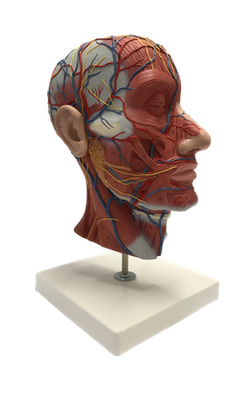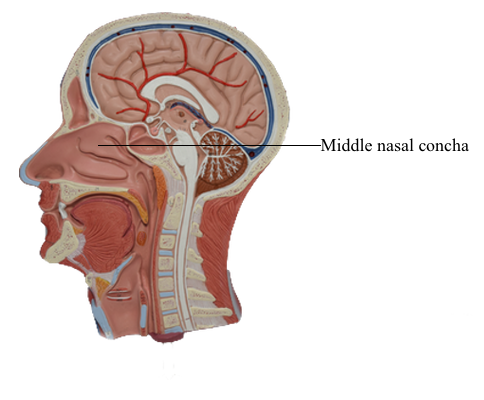Main Model

Nasal Cavity, Cavity of Pharynx and Oral Cavity : b Middle nasal concha

The nasal conchae (superior, middle, and inferior)
curve inferomedially, hanging like louvers or short curtains from the
lateral wall. The conchae (Latin shells) or turbinates of many
mammals (especially running mammals and those existing in extreme
environments) are highly convoluted, scroll-like structures that offer a
vast surface area for heat exchange. In both humans with simple
plate-like nasal conchae and animals with complex turbinates, a recess
or nasal meatus (singular and plural; passage(s) in the nasal cavity)
underlies each of the bony formations. The nasal cavity is thus divided
into five passages: a posterosuperiorly placed spheno-ethmoidal recess,
three laterally located nasal meatus (superior, middle, and inferior),
and a medially placed common nasal meatus into which the four lateral
passages open. The inferior concha is the longest and broadest of the
conchae and is formed by an independent bone (of the same name, inferior
concha) covered by a mucous membrane that contains large vascular
spaces that can enlarge to control the caliber of the nasal cavity. The
middle and superior conchae are medial processes of the ethmoid bone.
When infected or irritated, the mucosa covering the conchae may swell
rapidly, blocking the nasal passage(s) on that side.
The spheno-ethmoidal recess, lying superoposterior
to the superior concha, receives the opening of the sphenoidal sinus, an
air-filled cavity in the body of the sphenoid. The superior nasal
meatus is a narrow passage between the superior and the middle nasal
conchae into which the posterior ethmoidal sinuses open by one or more
orifices. The middle nasal meatus is longer and deeper than the superior
one. The anterosuperior part of this passage leads into a funnel-shaped
opening, the ethmoidal infundibulum, through which it communicates with
the frontal sinus. The passage that leads inferiorly from each frontal
sinus to the infundibulum is the frontonasal duct. The semilunar hiatus
(Latin hiatus semilunaris) is a semicircular groove into which the frontal sinus opens. The ethmoidal bulla (Latin bubble),
a rounded elevation located superior to the semilunar hiatus, is
visible when the middle concha is removed. The bulla is formed by middle
ethmoidal cells that form the ethmoidal sinuses.
The inferior nasal meatus is a horizontal passage
inferolateral to the inferior nasal concha. The nasolacrimal duct, which
drains tears from the lacrimal sac, opens into the anterior part of
this meatus. The common nasal meatus is the medial part of the nasal
cavity between the conchae and the nasal septum, into which the lateral
recesses and meatus open.